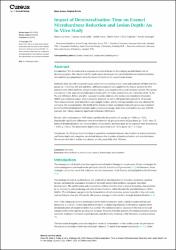Impact of demineralization time on enamel microhardness reduction and lesion depth: An in vitro study

View/
Date
2025Author
Ersen, Murat CanÇelik, Zeynep Ceren
Öztaş, Melek
Şahin, Merve
Tağtekin, Dilek
Yanıkoğlu, Funda
Metadata
Show full item recordCitation
Ersen M, Çelik Z, Oztas M, Şahin M, Tağtekin D, Yanıkoğlu F. (February 22, 2025) Impact of Demineralization Time on Enamel Microhardness Reduction and Lesion Depth: An In Vitro Study. Cureus 17(2): e79441.Abstract
Introduction: The duration of acid exposure is a critical factor in determining an individual's risk of
developing caries. The objective of this study was to investigate the correlation between demineralization
time and two key parameters: microhardness and depth of an enamel caries lesion.
Methods: Sixty recently extracted human teeth were mounted in acrylic resin and randomly divided into five
groups (n = 12). First, 400 grit and then 1,000 grit sandpaper were applied to the buccal surfaces for five
minutes each. Other surfaces, except buccal surfaces, were coated with an acid-resistant varnish. The groups
were stored in the same demineralization solution (pH 4.35-4.65), respectively, for a duration of 60, 72, 84,
96, and 108 hours. Before and after exposure to acidic solutions, the surface microhardness of samples
(SMH) was evaluated using a Vickers pyramid diamond tip with a 100 gram load applied for 15 seconds.
Three measurements were taken from each sample surface, and the average sample value was obtained by
averaging the measurements. The depth of the lesions in three specimens from each group was evaluated
from five different demineralized pits under a stereomicroscope. Data were analyzed by one-way ANOVA
and post-hoc Tukey's honestly significant difference (HSD) tests.
Results: After acid exposure, SMH values significantly decreased in all groups (p = 0.001; p < 0.01)
Statistically significant differences were shown between all groups in terms of Δhardness (p < 0.05). After 72
hours of demineralization, the microhardness values tend to decrease more as the exposure time increases (p
= 0.001; p < 0.01). The mean lesion depths were varied from 4.01 ± 0.71 µm to 13.7 ± 1.17 µm.
Conclusion: Our findings show that there is a positive correlation between the duration of demineralization
and lesion depth and a negative correlation between the duration of demineralization and microhardness.
We assume that initial lesions may deepen quickly, especially after 72 hours.
Source
CureusVolume
17Issue
2URI
https://www.cureus.com/articles/332903-impact-of-demineralization-time-on-enamel-microhardness-reduction-and-lesion-depth-an-in-vitro-study#!/https://hdl.handle.net/20.500.12780/1057

















